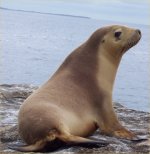 Did you know you can tell a sea lion (Neophoca cinerea) from a seal because it has got an external ear, seals have internal ears? Sea lions exist near both the antarctic and the arctic. The Australia Sea lions are found only on islands offshore of West Australia and South Australia. The Australian sea lion once bred in Bass Strait but was eradicated by the sealing industry (source). The bulls stay ashore to defend pregnant females. The (non-pregnant) females go out to hunt a wide variety of prey including several types of fish (including sharks), cephalopods, sea birds and rock lobsters. Females also display "fostering behavior", caring and nursing and protecting the young of others at her own expense. She will even adopt it when the natural mother is killed.
Did you know you can tell a sea lion (Neophoca cinerea) from a seal because it has got an external ear, seals have internal ears? Sea lions exist near both the antarctic and the arctic. The Australia Sea lions are found only on islands offshore of West Australia and South Australia. The Australian sea lion once bred in Bass Strait but was eradicated by the sealing industry (source). The bulls stay ashore to defend pregnant females. The (non-pregnant) females go out to hunt a wide variety of prey including several types of fish (including sharks), cephalopods, sea birds and rock lobsters. Females also display "fostering behavior", caring and nursing and protecting the young of others at her own expense. She will even adopt it when the natural mother is killed. Photo by Brian M Hunt. Licensed under GNU Free Documentation License.
The Australian sea lion, australian sealion is listed as Least Concern (LR/lc), lowest risk. Does not qualify for a more at risk category. Widespread and abundant taxa are included in this category, on the IUCN Red List of Threatened Species
Namings for the Australian sea lion
A young / baby of a Australian sea lion is called a 'pup or beach weaner'. The females are called 'cow' and males 'bull'. A Australian sea lion group is called a 'pod, colony, crash, flock, harem, bob, herd, rookery, team or hurd'.Countries
AustraliaSome facts about the
Australian sea lion
Adult weight : 190 kg (418 lbs)
Maximum longevity : 24 years
Female maturity :1095 days
Male maturity : 2191 days
Gestation : 258 days
Weaning : 570 days
Litter size : 1
Litters per year : 1
Weight at birth : 7.075 kg (15.565 lbs)
Weight at weaning : 59.724 kg (131.3928 lbs)

Custom Search